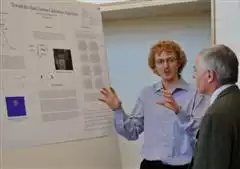Dissemination, Presentation, and Communication of Undergraduate Research in the Geosciences
By Patrick Burkhart
Student describing his research
DetailsStudents must understand, from the beginning of their research career, that the gracious dissemination of new knowledge is integral to science. (By "gracious", we caution that many a novice investigator has failed to confirm with their research mentor exactly who should be listed as co-authors on publications. A common error is to omit the faculty advisor, or other contributors, as co-authors on a submission. We suggest that if anyone but oneself owns any of the intellectual property in a product, has secured funds to make the research possible, guided or suggested the inquiry, led the research expedition, provided analyses, or made any of myriad other possible contributions, courtesy suggests that they should be offered co-authorship. Avoid harsh feelings and discuss co-authorship before submitting the abstract or manuscript! Mentors should be proactive in communicating expectations in these regards.) There are numerous opportunities to communicate outcomes in the geosciences, from the national level to those within local communities. If opportunities do not locally exist, faculty can make a meaningful contribution by proposing a new venue for intellectual exchange, such as an on-campus research symposium. General guidelines are available from Cutting Edge, Early Career Module
Publishing your Results to assist with understanding the nature of scientific reporting.
Guidance for faculty wishing to explore pedagogical approaches to disseminating results are available. Fava and Henry describe training techniquesto help students improve their communication skills.
National Venues
Many disciplinary societies regularly host meetings, or symposia, where undergraduate research is welcomed. These opportunities include:
Regional to Local Venues
Photo of annual student research symposium at Wittenberg University, in Ohio
DetailsIn addition to the sectional meetings of the Geological Society of America, smaller geological associations exist in many regions. For example, the Pittsburgh Geological Society
PGS hosts an annual student night in April, where selected students present orally and all submitters can present a poster.
Sigma Xi, the Scientific Research Society, operates many regional chapters, who not only provide grant programs to support undergraduate research, but also offer symposia to disseminate results. The
Regional Science Consortium, at the Tom Ridge Environmental Center of Presque Isle State Park in Erie, PA is an example of a group of Universities and other community partners, who have joined together for intellectual exchange, including a research symposium. Organizations like these can be found in many municipalities throughout the US.
Campus Research Day
As undergraduate research becomes common practice, many colleges and universities are developing an in-house symposium for undergraduate research, possibly including the publication of a journal containing articles or abstracts. For example, Slippery Rock University has offered its Symposium for Research and Scholarship, as well as its Journal of Scholarly Endeavor, for over ten years now.
Advice on Writing
An example of an in-house journal to disseminate research outcomes. Photo courtesy of Patrick Burkhart. There are many resources available to guide scientific writing. Professional organizations, such as the Geological Society of America, offer guidance including ethical concerns, general suggestions, and periodical specific guidelines, see
GSA Author information. One could also turn to Gopen and Swan (1990),
The Science of Scientific Writing, while Keyes (1999) illuminates the linkage between pursuing discovery and using writing to learn (link unavailable). Glynn and Muth (1994) place writing in the overall context of achieving
scientific literacy. Neil Irvine and Douglas Rumble III (1992) published
A writing guide for petrological (and other geological manuscripts), Journal of Petrology, p. 1-46, Oxford Univ. Press.
Advice on Presenting
- Barbara L. Dutrow (2007) wrote a respected discussion of techniques for preparing visualizations for scientific communication entitled Visual Communication: Do You See What I See? that was published in ELEMENTS April 2007 v. 3 no. 2 p. 119-126.




